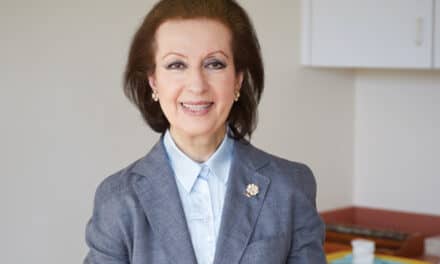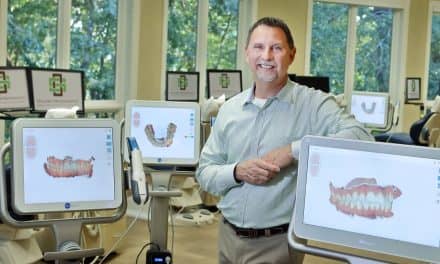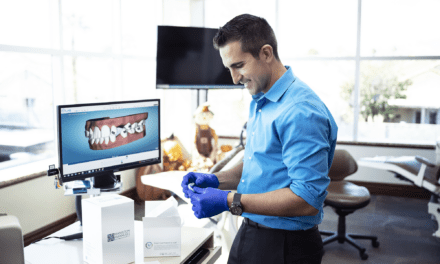by Rich Smith
Peter D. Maro, Jr, DMD, MS, is a team player on the ice and in the office
Less than a decade after arriving on the scene, Maro Orthodontics has emerged as a top practice in the New York City suburb of Rye. The reasons behind this rise to prominence range from an emphasis on cutting-edge technologies to the use of smart management techniques.
Perhaps most important is the high degree of cohesiveness solo practitioner Peter D. Maro, Jr, DMD, MS, has cultivated among his staff of five. “We work as a true team,” says Maro, who, as a once-and-present professional hockey player, knows a little something about how to rally a group of individuals with different talents and temperaments, inspire them to meet a challenge head-on, and go for the big win.
He sets the stage for this by, first and foremost, cross-training his crew.
“Take any sport,” he says. “The team works better together if everybody knows one another’s job out on the field. The same thing holds for the world of business. That’s why everybody in my office is cross-trained. If one of them is off on vacation or out sick, the rest of them can step right in and pick up the slack. The job that needs to get done that day will get done, which means there will be less stress in the office.”
|
Cross-training also allows Maro to run his practice with a lean staff. “I need fewer people than I might otherwise,” he says. “That helps me keep my costs down.”
Maro has even cross-trained his wife, Lynne, who doesn’t normally work for him unless she’s needed to fill in. “Then I call her up from the minors,” he jokes.
Training camp for Maro’s draft picks consists of learning the plays and running the drills. “We have a duties list that contains every job in the office,” Maro explains. “The new employee has to become completely familiar with everything on that list and check each item off the list as she masters it.”
Carry a Big Stick
It was Maro’s ambition as a kid growing up in New Jersey to be an orthodontist, but first to be a pro hockey player—a goaltender, to be exact.
“I had it all planned out,” he says. “After college, I was going to play pros for 6 or 7 years. Then after that I would go back to school and become an orthodontist.”
Although teenaged Maro was a letterman, he did not fit the stereotype of an academically challenged jock. “I earned good grades in all my classes, and I took a lot of pride in that,” he says.
No surprise, then, that both Yale and Dartmouth universities sought Maro for their respective Division I hockey teams. Unfortunately, Maro lacked the financial resources to pay tuition at either school, and sports scholarships were not available for those Ivy League halls of learning. Had he been able to enroll at Yale or Dartmouth, Maro would have found himself on a fast track to a National Hockey League (NHL) career. Instead, he went to less-expensive Division II schools—State University of New York (SUNY) at Potsdam and then, in his junior year, SUNY Geneseo—where things turned out well for him. “In Division II, I actually got to play more than would have been the case at a Division I school,” he says.

Maro was traded to the American Hockey League’s Utica (NY) Devils, a AAA affiliate team of the Rangers. His experience with the Devils proved to be one of too much bench-warming and not enough skating. Disappointed, Maro asked to be dropped down to the East Coast League, which would be another step removed from the NHL but one step closer to the ice. Devils management accepted his request, and Maro then became goalie for the Johnstown Chiefs.
With the Chiefs, Maro played early and often, and showed himself to be a terrific puck-stopper. Even so, Maro began to question the viability of his career path. “To make it back up to the pros, to get another crack at the NHL, I realized I was going to have to spend at least the next 5 to 6 years in the minors paying my dues,” he says. “If I made it back to the pros, I’d be there for maybe just 2 or 3 years, and that would be the end of it. I didn’t want to be in my 30s by the time I was ready to move on to the second phase of my life and start dental school.”
Lively Place
Maro quit the Chiefs after one season and enrolled himself at the University of Louisville in Kentucky, emerging from its school of dentistry in 1992 with a DMD and a master’s in oral biology. Maro then went on to the University of Maryland in Baltimore for his orthodontic training. He completed that program in 1995. From there, he moved to St Louis and joined a practice.
In 1998, Maro made his way to Rye and there purchased an established practice. Two years later, he bought the property next door so that he could construct an attractive, 3,800-square-foot, two-floor medical building for himself and one tenant. The finished product looks like a house, which blends perfectly with the residential-commercial neighborhood.
Maro Orthodontics occupies the second floor of the building. It’s a lively place, with televisions at each of the four chairs in the open-bay operatory. Treatment time passes quickly for patients, who use headsets while watching television so that the room doesn’t descend into a den of din. There is also an arcade-style game room in a loft above the waiting area, where old favorites such as Pac-Man and Centipede dominate. “I like video games that require no expertise to play—it’s more fun that way for the younger siblings of the patients,” Maro says.
The siblings are generally the only ones who can play the games, because the patients usually go almost straight from sign-in at the reception desk to the treatment chair. “We schedule in such a way that no one waits more than 5 minutes before being seen,” Maro says. “What helps us keep so tight a schedule is the fact that we don’t overbook and we have very, very few broken appointments. Broken appointments are rare, by the way, because patients receive automated reminder calls from us 48 hours in advance, and because we charge for not cancelling at least 24 hours in advance.”
Adherence to the schedule is also made possible by the remarkable degree of workflow efficiency Maro has achieved in his office. “We have lots of techniques that help us be efficient,” he says. “Automation is one. Use of efficiency-enhancing clinical aids, such as self-ligating brackets, is another.”

Clearly, a key element of Maro’s success in practice is his business savvy. He knows what makes his office tick, and he understands how to calculate the return on investment of any capital expenditure.
Maro also is a genuine problem-solver. There’s no better illustration of that than the consumer product he created for couples having difficulty sharing blankets in bed at night. “My wife was constantly stealing the covers while we slept,” Maro explains. “That gave me the idea for a product I called the Cover Cop.” The Cover Cop is basically an elastic belt that clips to the edges of the blankets and under the mattress. When it is duly secured, the offending partner is unable to gather up the covers in the process of rolling over. The product is available on the Internet and at Bed, Bath and Beyond stores across the country for less than $10. Maro and his wife serve as the models in the demonstration video, viewable at mycovercop.com.
As for the cutting-edge nature of Maro’s practice, he credits that in no small measure to his longtime participation in a study group known as the New-Conn Orthodontic Foundation. This 40-year-old, not-for-profit organization is composed of orthodontists from New York and Connecticut. Membership is always limited to 15, and is by invitation only. They meet once every 6 weeks at a hotel in White Plains, NY, to plan educational events and discuss not only clinical subject matter but also issues touching on practice operations and personal time management.
“We talk about things that help us become better orthodontists and smarter about the way we run our businesses,” Maro says, adding that it was a New-Conn discussion about the merits of the all-electronic office that inspired him earlier this year to invest $75,000 in digital x-ray and automated charting equipment.
The most important function of the New-Conn study group is a seminar it puts on every other year for orthodontists from across the region. The next such event will take place April 13 to 14, 2007, and will focus on temporary anchorage devices. (For more information, visit the group’s Web site at newconnortho.org.) These seminars—and other activities of the group—generate revenue, but New-Conn plows it back into orthodontic education. “We help fund residency programs at nearby dental schools,” Maro says. He currently serves as treasurer of the group.
Comeback Kid
Maro uses a variety of conventional internal and external marketing techniques to attract referrals to his practice, but one of his most effective is simply his visibility in the community: Maro is an officer of Rye’s chapter of the Rotary Club, he donates regularly to a host of worthy causes, and he sponsors numerous local sport teams. He also coaches a youth hockey team known as the Rye Rangers.
The youngsters on that team hold Maro in extrahigh regard not only because of his hockey past but because he’s still in the game and about to make a return of sorts to the pros. For a while now, Maro has played recreational hockey in a senior-A men’s league. Recently, he was asked to be a backup goalie for a semiprofessional, single-A team taking shape in nearby Danbury, Conn, as part of the Northeast Hockey League. Says Maro, “They play a 20-game season, entirely on the weekends. I figure I’ll play four or five of those games—not bad for an old man.”
Even at 41, Maro can’t legitimately claim to be an old man. However, he does expect to play hockey at one level or another until well into his sunset years. In fact, he says he hopes to keep at it right up to the day he shuffles off this mortal coil, just like his role model, the late Charles M. Schulz, a hockey enthusiast best known as creator of the beloved “Peanuts” comic strip.
In the here and now, however, the hard-working Maro guards against the tendency to lose sight of what’s important—namely, his family, which, in addition to himself and Lynne, consists of children Elise, 6, Peter III, 4, and Christian, 1.
“It’s easy to become too absorbed in your practice,” he admits. “I’ve had to remind myself that my kids are only going to be little for a short time, and I don’t want to miss out on that by spending endless hours in the office. It used to be that my day off was a day of catching up on paperwork. No more. Now it’s a day I spend with my family.
“Finding balance in life is what’s important. If I can get my gross up by 7% for the year, that’s great—but it won’t be worth the gain if the only way to make that happen is if I have to spend an extra 20 hours a month away from my family. I want a more fulfilling life, not necessarily a bigger bank account.”
Rich Smith is a contributing writer for Orthodontic Products. For more information, please contact [email protected].
|
Picking the Right Team Hockey player Peter D. Maro, Jr, DMD, MS, tries to counter such forces in his Rye, NY, practice by starting off with players who offer not just talent but also the right personality. “In my opinion, the employee’s personality is the most important consideration in making a hiring decision,” he says. “Whoever I bring aboard has to be someone who is enthusiastic, friendly, and adaptable.” Notably, no one joins the Maro Orthodontic team unless the team agrees to it. “I let my staff participate in the hiring decision,” Maro says. He currently employs three chairside assistants, one receptionist, and an office administrator. “They have a part in the interview process, and then they vote on whether the candidate would make a good selection.” Maro votes too, and his vote counts twice. (Otherwise, with five voting staffers, there would exist the possibility of a tied ballot outcome.) “Even with my two votes, I can easily be outvoted by the staff when it comes to picking a team member,” he says. Maro insists on team participation in hiring to ensure that everyone is happy with the selection. “If I make the decision myself and I hire someone that everybody else hates, then I’ve thrown my team out of balance,” he explains. “And what you learn real fast in hockey is that, if your team is out of balance, you’ve got disarray and you’re going to lose the game even before you hit the ice.” |





